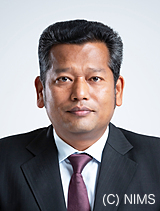HOME > Profile > SHRESTHA, Lok Kumar
- Address
- 305-0044 1-1 Namiki Tsukuba Ibaraki JAPAN [Access]
Accepting Students
- Associate professor, Degree Program in Materials Innovation, Graduate School of Science and Technology, University of Tsukuba (NIMS Joint Graduate School)
- Associate professor, Degree Program in Materials Innovation, Graduate School of Science and Technology, University of Tsukuba (NIMS Joint Graduate School)
Research
PublicationsNIMS affiliated publications since 2004.
Published patent applications
Society memberships
日本化学会, The Asian Society for Colloid and Surface Science (ASCASS)
Research Center for Materials Nanoarchitectonics (MANA)
フラーレンベースの新しいナノ多孔質炭素材料の設計
自己組織化,機能性材料,センシング,エネルギー貯蔵,エネルギー変換,生物学的応用
Overview
Fullerenes (C60 or C70) are zero-dimensional functional molecules that undergo supramolecular self-assembly due to their high symmetries and extended π-conjugated systems and form various shape-controlled micro- or nanosized crystalline objects. In NIMS, we have developed method to directly convert these highly crystalline π-electron-rich fullerene nanomaterials into hierarchically porous graphitic carbon materials with high surface area and interconnected pore structures by high-temperature carbonization, which have significant potential as electrode materials in state-or-art electrochemical energy storage supercapacitors.
Novelty and originality
Porous carbon materials obtained from fullerene crystals exhibit a unified shape and size followed by superior electrochemical energy storage performance over conventional carbon materials because of their large surface areas, improved electrical conductivities, well-defined pore size distributions, and hierarchical and interconnected pore architectures.
Details
We have recently demonstrated novel hollow carbon spheres with hierarchically porous architectures by high-temperature carbonization of self-assembled fullerene-ethylenediamine hollow spheres (FE-HS). FE-HS were prepared by using a dynamic liquid-liquid interfacial precipitation (DLLIP) method at ambient conditions of temperature and pressure. High temperature carbonization (at 700, 900, and 1100 °C) of the FE-HS yielded nanoporous (micro/mesoporous) hollow carbon spheres with large surface areas (612 to 1616 m2 g-1) and large pore volumes (0.925 to 1.346 cm3 g-1) dependent on temperature applied. The sample obtained by carbonization of FE-HS at 900 °C (FE-HS_900) displayed optimum surface area and exhibited remarkable electrochemical electrical double-layer capacitance properties in aq. 1 M sulfuric acid due to its well-developed porosity, interconnected pore structure, and large surface area. The symmetric supercapacitor cell assembled using FE-HS_900 attained 164 F g-1 at 1 A g-1 with sustained 50% capacitance at 10 A g-1accompanied by 96% cycle life and 98% coulombic efficiency after 10,000 consecutive charge/discharge cycles.
Summary
Thermal annealing processes disrupt the fullerenes carbon-only skeleton contained within the self-assembled structures, maintaining the basic morphology of the starting material, accompanied by surface roughening and the emergence of a high porosity carbon network essential to enhance the energy storage, conversion, and sensing performance.


